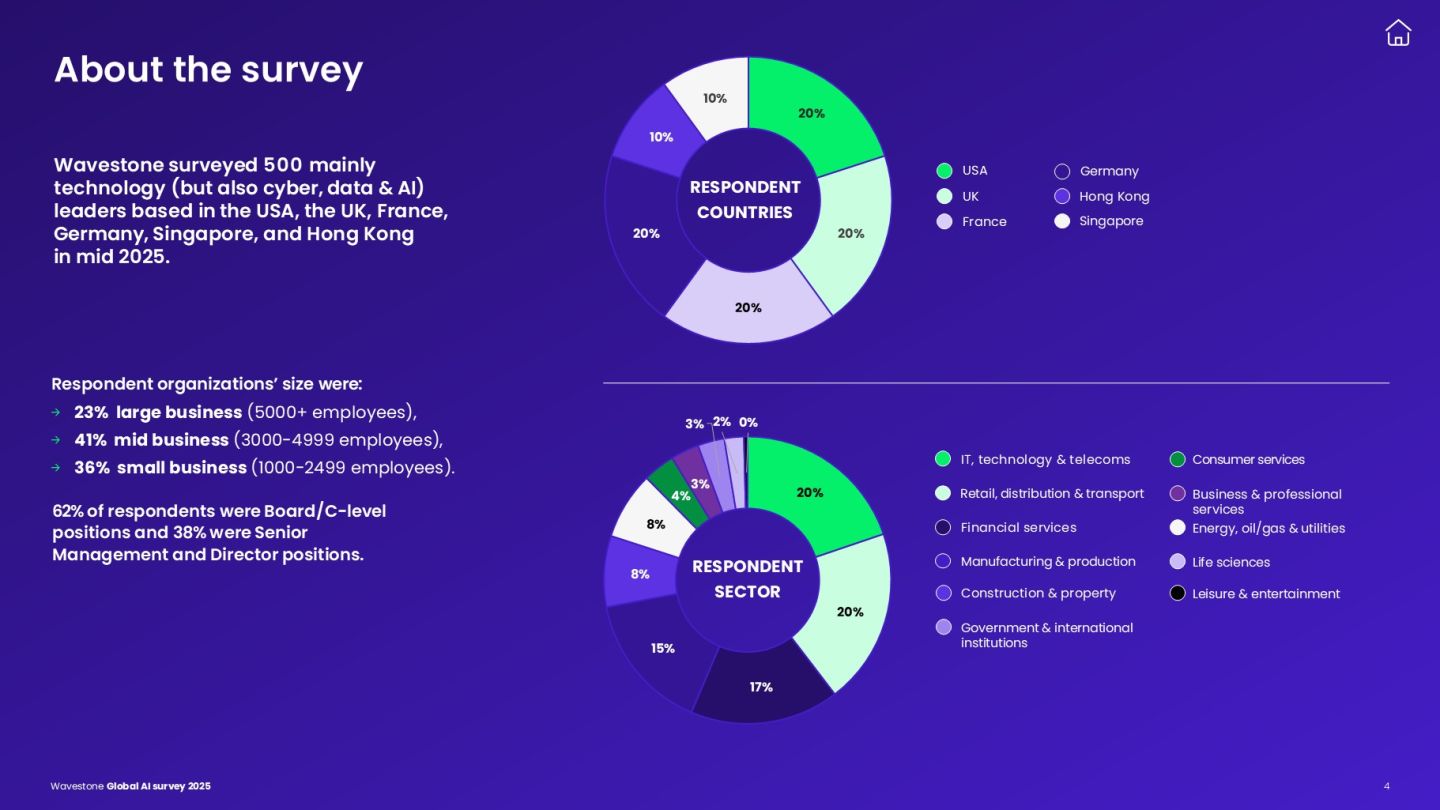Global AI survey 2025: The paradox of AI adoption
Published October 14, 2025
- Data & AI

Key takeaways
- For the third year in a row, Wavestone surveyed 500 executives across Europe, North America, and Asia. Their insights confirmed both the centrality of AI and the paradox of a technology celebrated in boardrooms yet fragile in execution.
- 70% of organizations already place AI at the heart of their business strategy
- From everyday tools to infrastructure, leading organizations are laying the foundations for scalable AI
- While most organizations see tangible benefits, 46% do not yet have a structured ROI measurement framework
- Among AI most mature companies, the top hurdles are market complexity and regulation. While others struggle mainly with talent shortages, interoperability, budget and AI adoption
- 84% of organizations integrate sovereignty into their strategy, while focus on environmental impact has fallen to 29% (vs. 46% last year)
- Enterprises are caught up in Agentic FOMO
No strategy without AI
For most organization, AI has become a central pillar of corporate strategy. With 70% already embedding AI significantly, the focus is shifting from AI adoption to effective scaling and integration, like for Helvetia Group and the new AI platform we helped them implement. Regional differences persist, but the overall trend confirms that ignoring AI is no longer an option.
Mature organizations have moved beyond the experimental phase with AI, they are now building the foundations for its sustained integration. Investments are increasingly directed toward invisible but critical enablers signaling a shift from short-term pilots to long-term transformation. This reflects a growing maturity, where AI is seen not just as a tool, but as a structural component of future business models.
-
90% of companies now include it in their business strategy
-
13% of the IT Budget is allocated to AI
-
45% of respondents say they are behind most competitors, down from 75% in 2024

AI maturity is not only about quick wins
AI is now seen as a pervasive driver of value, with organizations identifying pockets of impact ranging from operational efficiency and customer experience to employee wellbeing and innovation.
Certain domains stand out as most exposed to disruption, notably IT and cybersecurity, knowledge management, and customer-facing functions such as marketing and sales.
The value is visible but not fully captured: while use cases are multiply, ROI remains uneven, creating a divide between leaders embedding governance and metrics and those at risk of blind spending.
AI outcomes seem too good to be true
Nearly all organizations acknowledge substantial AI risks, with security, compliance, and trust dominating the agenda. Risk perception evolves with maturity: beginners worry about resistance and reputation, while advanced players focus on governance and regulatory alignment. Managing these risks demands more than technical fixes, it requires robust governance, ethical safeguards, and human-centric planning
Barriers to AI adoption are nearly universal, but their nature shifts with maturity. Less mature organizations struggle with talent shortages, silos, and cultural resistance, making change management and early wins critical. Advanced players, by contrast, face the challenge of scaling responsibly, navigating market complexity, regulatory requirements, and the need for specialized expertise.
Is sovereignty the new green?
While 91% of organizations report measuring AI’s environmental impact, only 29% do so systematically across all use cases. This reflects uneven maturity in sustainability practices. Even if there is a step back from previous year, strategic AI adopters lead the way, linking governance with environmental responsibility.
Digital sovereignty is now a mainstream concern, with 84% of organizations factoring it into their AI strategies. However, only 34% treat it as a top priority, while others balance it against performance and cost. Geopolitical and regulatory pressures are driving this shift. The divide reflects broader tensions in global AI ecosystems.

Our survey reveals a critical inflection point: while nearly all organizations acknowledge AI’s transformative potential, success now depends on their ability to translate ambitious strategy into disciplined execution, managing both risks and competitive pressure. Yet discipline alone will not be enough — competitive advantage will belong to those who can rethink how they operate, learn, and transform in a world shaped by intelligent systems.
A fragmented AI landscape
The AI provider landscape is fragmented, with no dominant model. Most organizations pursue hybrid strategies that mix internal builds with external partners or anchor to a hyperscaler to move fast while keeping some control. Independence approaches (multi-vendor, in-house, or open-source) remain minority choices, showing that sovereignty is more aspirational than mainstream. This fragmentation reflects the trade-offs between speed, control, risk mitigation, and long-term strategic freedom.
AI adoption begins with plug-and-play tools embedded in productivity and enterprise software, often accelerated by employee experimentation. But as organizations scale, the focus shifts toward solid foundations (data, cloud, governance platforms, and custom models) that enable enterprise-wide integration. At the same time, AI agents are proliferating rapidly, with enterprises already testing highly autonomous capabilities. The real challenge is no longer building but governing, embedding trust, compliance, and strategic alignment in an increasingly complex landscape.
-
67% avoid a too high dependency on a single AI technology provider
-
35% use agents that can dynamically select tools or actions based on real-time context or input
-
AI workforce enablement is near-universal
AI is already reshaping work, but only partially: on average, 30% of target users have meaningfully changed the way they work. Adoption remains concentrated, with most organizations capped at 30–40% and only 7% reaching more than half their workforce. This points to an intermediate stage of maturity, where real change is visible but not yet at scale. Reaching majority adoption will require stronger investment in change management and process integration.
This is where workforce enablement comes in. It is now nearly universal, with organizations combining training, communication, and change management to build both trust and skills. Leadership engagement and external partners are emerging as key differentiators.
Survey methodology

Survey’s methodology
- Data & AI
Wavestone Global AI survey 2025
pdf · 8916KO
Uncover what’s driving AI transformation in 2025

